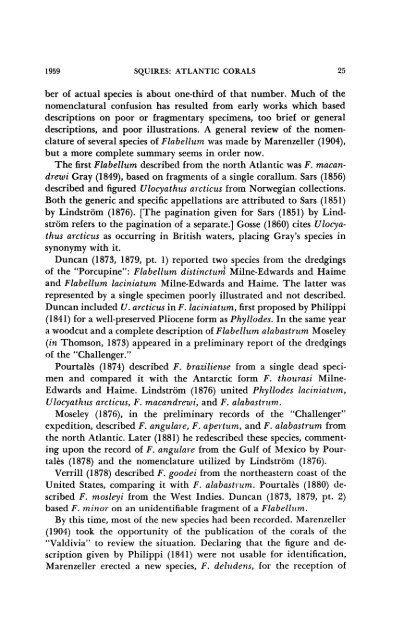MXieuicanJAuscum - American Museum of Natural History
MXieuicanJAuscum - American Museum of Natural History
MXieuicanJAuscum - American Museum of Natural History
You also want an ePaper? Increase the reach of your titles
YUMPU automatically turns print PDFs into web optimized ePapers that Google loves.
1959 SQUIRES: ATLANTIC CORALS<br />
25<br />
ber <strong>of</strong> actual species is about one-third <strong>of</strong> that number. Much <strong>of</strong> the<br />
nomenclatural confusion has resulted from early works which based<br />
descriptions on poor or fragmentary specimens, too brief or general<br />
descriptions, and poor illustrations. A general review <strong>of</strong> the nomenclature<br />
<strong>of</strong> several species <strong>of</strong> Flabellum was made by Marenzeller (1904),<br />
but a more complete summary seems in order now.<br />
The first Flabellum described from the north Atlantic was F. macandrewi<br />
Gray (1849), based on fragments <strong>of</strong> a single corallum. Sars (1856)<br />
described and figured Ulocyathus arcticus from Norwegian collections.<br />
Both the generic and specific appellations are attributed to Sars (1851)<br />
by Lindstrom (1876). [The pagination given for Sars (1851) by Lindstrbm<br />
refers to the pagination <strong>of</strong> a separate.] Gosse (1860) cites Ulocyathus<br />
arcticus as occurring in British waters, placing Gray's species in<br />
synonymy with it.<br />
Duncan (1873, 1879, pt. 1) reported two species from the dredgings<br />
<strong>of</strong> the "Porcupine": Flabellum distincturX Milne-Edwards and Haime<br />
and Flabellum laciniatum Milne-Edwards and Haime. The latter was<br />
represented by a single specimen poorly illustrated and not described.<br />
Duncan included U. arcticus in F. laciniatum, first proposed by Philippi<br />
(1841) for a well-preserved Pliocene form as Phyllodes. In the same year<br />
a woodcut and a complete description <strong>of</strong> Flabellutm alabastrutm Moseley<br />
(in Thomson, 1873) appeared in a preliminary report <strong>of</strong> the dredgings<br />
<strong>of</strong> the "Challenger."<br />
Pourtalks (1874) described F. braziliense from a single dead specimen<br />
and compared it with the Antarctic form F. thourasi Milne-<br />
Edwards and Haime. Lindstrom (1876) united Phyllodes laciniatumn,<br />
Ulocyathus arcticus, F. macandrewi, and F. alabastrum.<br />
Moseley (1876), in the preliminary records <strong>of</strong> the "Challenger"<br />
expedition, described F. angulare, F. ape} turm, and F. alabastrum from<br />
the north Atlantic. Later (1881) he redescribed these species, commenting<br />
upon the record <strong>of</strong> F. angulare from the Gulf <strong>of</strong> Mexico by Pourtales<br />
(1878) and the nomenclature utilized by Lindstrom (1876).<br />
Verrill (1878) described F. goodei from the northeastern coast <strong>of</strong> the<br />
United States, comparing it with F. alabastrum. Pourtales (1880) described<br />
F. mosleyi from the West Indies. Duncan (1873, 1879, pt. 2)<br />
based F. minor on an unidentifiable fragment <strong>of</strong> a Flabelltrm.<br />
By this time, most <strong>of</strong> the new species had been recorded. Marenzeller<br />
(1904) took the opportunity <strong>of</strong> the publication <strong>of</strong> the corals <strong>of</strong> the<br />
"Valdivia" to review the situation. Declaring that the figure and description<br />
given by Philippi (1841) were not usable for identification,<br />
Marenzeller erected a new species, F. deludens, for the reception <strong>of</strong>
















